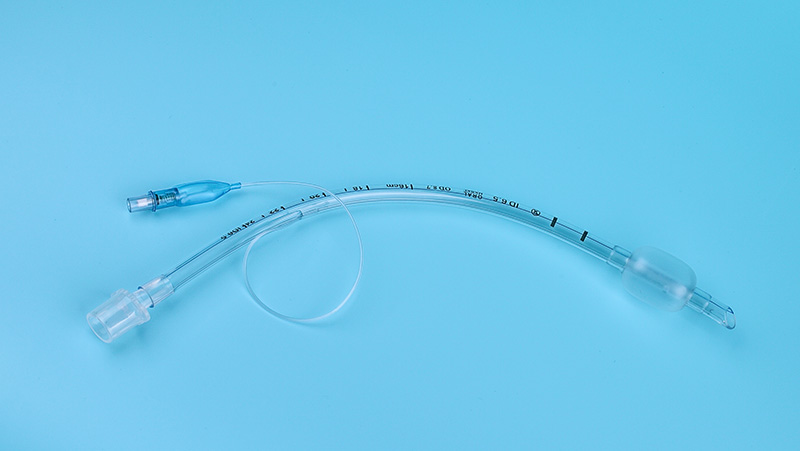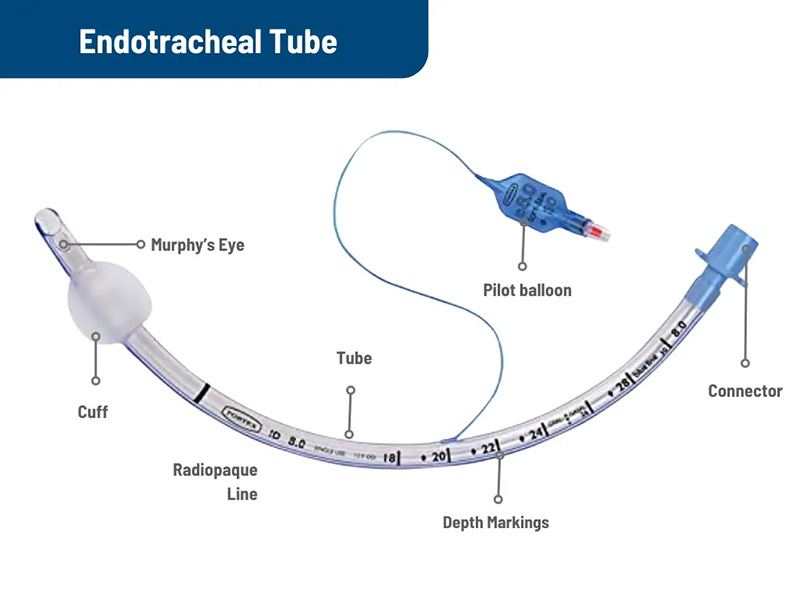In modern medicine, especially in airway management and anesthesia, the endotracheal tube (ETT) plays a life-saving role. This guide explains everything you need to know about endotracheal tubes—from their purpose and structure to their types and the process of intubation.
What is an Endotracheal Tube?
An endotracheal tube is a flexible medical device inserted into the trachea (windpipe) to maintain an open airway, especially during surgery or emergency care. It allows the direct delivery of oxygen, anesthetic gases, and other medications to the lungs.
Why Do We Use Endotracheal Tubes?
ETTs are crucial in various clinical scenarios, such as:
Airway obstruction (something caught in the airway, blocking the flow of air).
Cardiac arrest (sudden loss of heart function).
Your neck, abdomen or chest gets injury or trauma, that affects the airway.
When the person can’t breathe spontaneously when he is inconscious or serious ill.
To do a surgery which will make you unable to breath by yourself.
Temporary breathing failure.
Risk for aspiration.
Components of an Endotracheal Tube
Key components of an endotracheal tube include:
- Tube body: Made of plastic or rubber, inserted into the trachea
- Cuff: Inflated to seal the airway and prevent aspiration
- Pilot balloon: Reflects cuff pressure
- 15mm universal connector: Connects to ventilators or manual bags
- Murphy eye: Ensures airflow even if the tip is blocked
Types of Endotracheal Tubes
ETTs come in various forms tailored to patient needs and surgical contexts:
- Cuffed or uncuffed tubes
- Oral or nasal tubes
- Preformed (RAE) tubes
- Reinforced tubes
- Double-lumen tubes (DLTs) for lung isolation
Difference Between Intubation and Endotracheal Tube
Many confuse these terms, but they refer to different things:
- Intubation: it is a medical procedure in which a tube is placed into the windpipe (trachea) through the mouth or nose. In most emergency situations, it is placed through the mouth.
- Endotracheal tube: The physical device inserted during intubation
How to Proceed with Intubation (Step-by-Step)
The intubation process involves the following steps:
- Prepare all necessary equipment
- Preoxygenate the patient
- Administer sedatives and muscle relaxants
- Visualize vocal cords using a laryngoscope
- Insert the endotracheal tube into the trachea
- Inflate the cuff to seal the airway
- Confirm placement via capnography and auscultation
- Secure the tube and monitor
Benefits of Endotracheal Tubes
It can keep the airway open, so the doctors can give oxygen, medicine, or anesthesia for some critically ill or unconcious patients.
Support breathing in some certain illnesses, like pneumonia, emphysema, heart failure, collapsed lung and so on.
Help to remove blockages from the airway.
Get a better view of the upper airway for the provider.
Protect the lungs of some people who are unable to protect their airway and are at risk for breathing in fluid (aspiration).
Why Choose Disposable Endotracheal Tubes?
Disposable ETTs offer enhanced safety and convenience:
- Improved infection control
- Eliminate cleaning or sterilization needs
- Cost-effective and time-saving
- Available in multiple sizes for better fit
Best Practices for Selection and Use
Choose the appropriate ETT based on:
- Patient age and airway anatomy
- Planned procedure and duration
- Material compatibility (MRI-safe, latex-free, etc.)
Always confirm proper placement with imaging and clinical signs to avoid complications.
Conclusion
The endotracheal tube is a critical tool in anesthesia and emergency care. Knowing how to choose the right type, perform intubation safely, and monitor usage ensures better patient outcomes and optimized airway management. Keep up with best practices to make the most of this essential medical device.
Frequently Asked Questions (FAQ)
What is the purpose of an endotracheal tube?
It is used to maintain an open airway and allow for mechanical ventilation or anesthesia delivery.
How is an endotracheal tube different from intubation?
The endotracheal tube is the device, while intubation is the act of inserting the tube into the trachea.
Are there different types of endotracheal tubes?
Yes, including cuffed, uncuffed, oral, nasal, laser-resistant, and double-lumen tubes.
Is the use of disposable ETTs better?
Disposable ETTs reduce infection risks and eliminate cleaning steps, making them safer and more efficient.
Post time: Oct-24-2023









